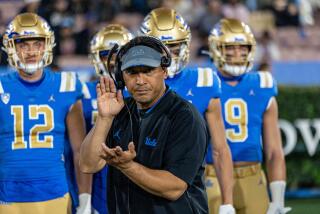Supervisor of Swarm : Success of Arizona’s Nationally Recognized Defense Has Brought Celebrity to Coordinator Larry Mac Duff
Arizona defensive coordinator Larry Mac Duff and the Wildcat coaching staff have become unwilling celebrities because of Desert Swarm.
Hundreds of college, community college and high school coaches have descended on Tucson to learn about the Wildcats’ defense, which came to national prominence early in the 1992 season.
“We take pride in the fact that others want to use our system,” Mac Duff said. “We’re happy to share some of the basics. But you have to understand that our players made the system we have work. The attention we get is because of them.”
Among the best current players are Tedy Bruschi, an All-American defensive end, and Sean Harris, an All-Pacific 10 Conference linebacker.
Bruschi, a junior, had 15 tackles for losses this season. He was voted the team’s most valuable player in 1993 despite playing with nose guard Rob Waldrop, the Outland Trophy winner.
He was also the game MVP when Arizona defeated Miami, 29-0, in the 1994 Fiesta Bowl.
Harris was one of 13 semifinalists for the Butkus Award this season and led Arizona with 89 tackles. He missed a day of practice last week so he could return to Arizona to graduate with a degree in sociology.
“They are just tremendous players,” Mac Duff said.
Arizona had hoped to be in Southern California this week preparing for the Rose Bowl.
But a 10-9 loss to Oregon and a 45-28 thrashing by USC left the Wildcats with a date with Utah in the Freedom Bowl on Tuesday at Anaheim Stadium.
In the final game of the season, Arizona rallied for 13 points in the fourth quarter to defeat rival Arizona State, 28-27, to earn a second-place tie in the Pac-10.
“This is a really important game for us,” Mac Duff said. “We didn’t play Arizona-style football against USC or Arizona State. We’re just not used to letting people in our end zone.”
The birth of the defense’s success came only after a disastrous 1991 season. The Wildcats finished 4-7 and gave up 361 points, including 54 in two consecutive games.
It was time for a change.
“We wanted to do something that would bring winning football back to Arizona,” Mac Duff said. “Fortunately, we have a head coach in Dick Tomey who is committed to doing what it takes to make the defense an important part of the program.”
One of the steps taken was the hiring of Rich Ellerson to work with the defensive line. Ellerson had been coaching at Hawaii before coming to Arizona.
The staff then designed a defense that would shut down the running attack of opponents, using a five-man front with one player free to play either the run or pass.
The results have been staggering. In the last 35 games, opponents have averaged 50.4 yards rushing and the Wildcats were second in the nation against the run in 1992, first in 1993.
This season, Arizona’s defense was second in the nation against the run (65 yards a game) and no individual and only two teams (Oregon State and USC) rushed for more than 100 yards in a game against the Wildcats. The defense gave up 174 points, 76 in the team’s three losses.
All the success has put Mac Duff, in his 24th year as a coach, in the national spotlight.
As a player and as a coach--he also coaches the Wildcats’ linebackers--Mac Duff has always stressed preparation.
“We’re the first ones in meetings and the last ones to leave,” Harris said. “I don’t like being in meetings that long but I know that on Saturday I’m going to know everything about the offense there is and that makes me a better football player.”
Mac Duff’s experience and success have made him a prime candidate to become a head coach. Oklahoma asked permission to speak with Mac Duff before hiring Howard Schnellenberger.
“He’s grown every year as a coach,” Tomey said. “But he’s not a self-promoter. He’s always worried about the other guy. He’s very loyal to our football program.”
Mac Duff, 46, said he would like to be a head coach at some point but isn’t sure when that would be.
“The right situation would have to come along,” he said. “It’s been a lifetime goal of mine. But right now I’m trying to do the very best job with the job I have.”
Mac Duff grew up in Fullerton and attended Sunny Hills High, were he originally had hopes of becoming an architect. He changed his plans once he discovered football. He was a standout linebacker and the defensive player of the game in the 1966 Orange County All-Star game.
After graduating, he played defensive end at Fullerton College for Coach Hal Sherbeck.
He then went on to play at Oklahoma for Coach Chuck Fairbanks in 1968 and 1969. The 1968 team tied Kansas for the Big Eight title. Tomey was an assistant at Kansas at the time.
But Mac Duff and Tomey didn’t meet until a few years later when Tomey was at UCLA and he was recruiting Gary Carter, who instead went on to become an all-star catcher.
Mac Duff got his first college experience working on Sherbeck’s staff at Fullerton from 1974 to 1979. The two have remained close.
“He’s like a son to me,” said Sherbeck, who retired in 1992. “His whole life has been spent preparing himself to be the best football coach he could be.”
Mac Duff left Fullerton for Stanford in 1980 and was there for four years under Coach Paul Wiggins. He went to Hawaii in 1984 and joined Tomey as his defensive coordinator. The pair came to Arizona in 1987.
More to Read
Go beyond the scoreboard
Get the latest on L.A.'s teams in the daily Sports Report newsletter.
You may occasionally receive promotional content from the Los Angeles Times.










